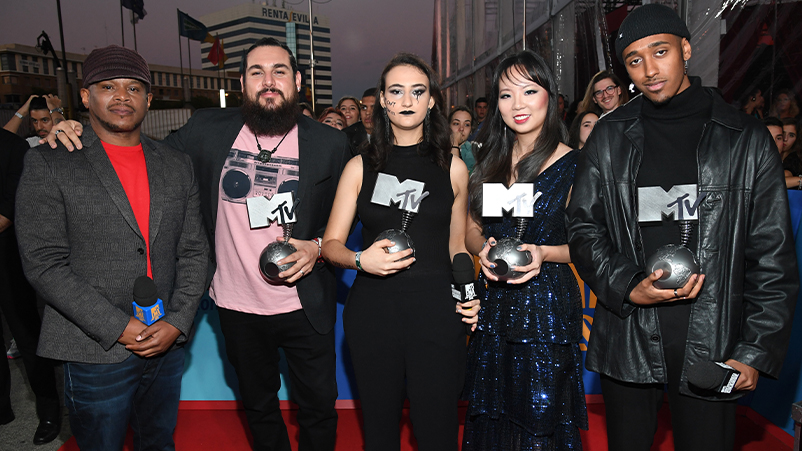Brands can march too

MTV’s 2019 Generation Changemakers Honourees.
Reflecting opinion or shaping it, amoral or moral, part of the problem or part of the solution. The debate over the role of media in society can be as heated as a late-night news panel. But rather than get lost in the weeds of opinion or ideology, fact or fiction, agenda or independence, what if we simply applied the rule of intent.
While it’s important to acknowledge the world of media is more expansive than ever and includes everything from an animated feature to an animated talk back radio host, each format, channel, perspective and even storyline plays some role in a broader narrative.
That narrative is shaped by intent.
If you think about the purchase decisions you make, a brand’s intent is crucial. The more positive contribution to social good, the more reason to choose a brand. So, if this is why more and more consumers choose brands, why shouldn’t brands choose media companies by the same principle? At the end of the day, the company or companies we keep says more about us than anything.
Buying media is also buying a brand.
So, let’s imagine the major media players could be found on the shopping aisle. A customer, that’s you big advertiser, walks along wondering what is the right brand, or mix of brands for them. However, what if one or more of these brands was not entirely a model corporate citizen. What if they routinely peddled misinformation about climate change, hired spokespeople who vilified rape victims, or failed to remove extremist messaging on the pack? What if the brand had a well-known boys club that not only excluded women but chased them with lawyers if they dared speak up? Or what if the brand had a sub-brand targeting racists?
Chances are they wouldn’t be chosen. Sales would collapse. The brand would die. A fast-moving consumer good would move fast into oblivion.
It goes without saying, no media company has a blemish free history. At 10 ViacomCBS we are the first to acknowledge what we can do better and have established numerous internal programs and external campaigns to find solutions to social issues, such as MTV generation change: Black lives matter and our company-wide production policy – No Diversity, No Commission.
Even recently we welcomed Fremantle conducting an independent review on their production of Neighbours regarding allegations of racism and discrimination as this has no place in our industry, across broadcasters or the production partners they engage.
But as an industry surely, we can do better. Surely our actions must be part of the decision-making process just as consumers judge the brands who use our channels, papers and platforms.
Some in media assuage their social responsibility by claiming they ‘give viewers what they want’. In reality, certain media channels are merely feeding viewers more 'engaging' or ‘enraging’ content as a tactic to grow margins by stoking those who feel marginalised, even if they are paradoxically the least marginalised.
Some argue they are offering counter arguments and championing free speech. But free speech is anchored to a marketplace of ideas where all voices have meaningful access rather than digital echo chambers or false realities. This is a whole other discussion but suffice to say that possibly the ‘free speech’ card is no longer relevant in the digital era where a false narrative can be created, promoted and propagated by a 3am tweet from the toilet.
Some explain aggressive tactics as the argy-bargy of business. Really? Does this wash anymore? It certainly didn’t when Facebook pulled news in 24 hours including critical communication channels for first responders. The truth is the lines have blurred so much between a corporation and a brand. Consumers can’t see a difference, even if a few executives think they can.
Intent matters more than ever.
Determining intent of a media company is not easy but here are some questions brands can ask.
Is the organisation working towards public good?
Is the organisation promoting a diverse and representative culture?
Does it seek to narrow the lens rather than open up the conversation?
Does it exist to inform, entertain or wield power?
Or will it ignore public opinion and defend its most senior executives no matter how indefensible the
behaviour?
People march. Brands can too.
Imagine if aside from the commercial logic of CPM, Reach, Frequency, and Demographics we also considered Empathy, or whether a media channel had a deeper connection with viewers and readers based on a commitment to positive societal outcomes. It seems odd this hasn’t really happened given the age groups of those buying media - Millennials and Gen Z are the most willing to purchase with purpose. The ‘why?’ before this ‘buy’, is why isn’t it happening.
Media companies are not to blame for all of our challenges. However, they hold a disproportionate power in how we solve them. That’s why this moment matters. In truth, it matters more than ever. COVID supercharged high intent purchasing, and high corporate expectation. (Deloitte Millennial study 2020). People came together in a crisis and against what many want us to believe, we have more in common than we think. The narrative was more supportive, more positive, more progressive and more powerful.
So, let’s use that power, or more accurately use your power to make a difference. Media can do so much more to enable and embolden positive change. Media can elevate the conversation. And best of all, media can work alongside brands to help address issues, to right the wrongs, to connect with consumers in culturally relevant ways, to build relevance with the most discerning and purpose driven consumer we have ever seen.
If you feel governments can move faster, you can move on Monday. The buck can stop here.
